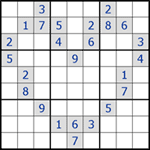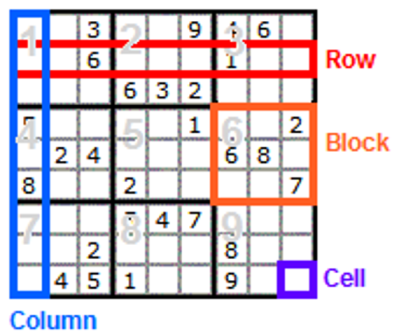What is Sudoku?

What are the rules?
The game simply requires that the grid is completed with different numbers in every row, column and box. The existing numbers cannot be changed or moved. In a correctly formed Sudoku puzzle, there is one unique solution. Sudoku does not require any knowledge of mathematics to solve. However, Sudoku does require logic and reasoning.
1. for each row: every number from 1 to 9 should occur exactly once
2. for each column: every number from 1 to 9 should occur exactly once
3. for each 3×3 square with a thicker border (there are 9 of them): every number from 1 to 9 should occur exactly once
The terminology

The smallest unit in the 9×9 grid known as "Cell". Sometimes a cell also known as "square".
A "Column" made up of 9 vertical cells show in BLUE colour.
A "Row" made up of 9 horizontal cells show in RED colour.
A "Block" made up of 3×3 sub grids. (as known as “regions”),

The 'buddy' of a square is the squares that share a row, column or 3x3 blocks.
e.g. the buddies of red circle Row7 Column3 (R7C3) are shown below. Every square has 20 buddies.